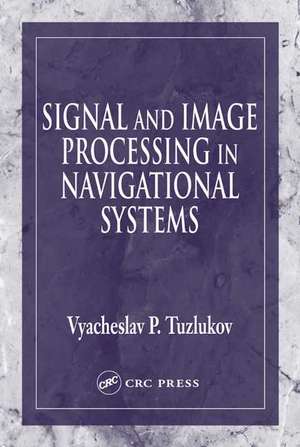Signal and Image Processing in Navigational Systems: Electrical Engineering & Applied Signal Processing Series
Autor Vyacheslav Tuzlukoven Limba Engleză Hardback – 29 noi 2004
Signal and Image Processing in Navigational Systems introduces us to the generalized approach, and then delves rigorously into the theory and practical applications of this approach. This volume represents the most in-depth discussion of the generalized approach to date, providing many examples and computer models to demonstrate how this approach raises the upper limits of noise immunity for navigation systems, leading to better detection performances.
This book is vital for signal and image processing experts, radar, communications, acoustics, and navigational systems designers, as well as professionals in the fields of statistical pattern recognition, biomedicine, astronomy, and robotics who wish to extend the boundaries of noise immunity and improve qualitative performance of their systems.
Preț: 1470.87 lei
Preț vechi: 1975.77 lei
-26% Nou
Puncte Express: 2206
Preț estimativ în valută:
281.46€ • 300.97$ • 234.67£
281.46€ • 300.97$ • 234.67£
Comandă specială
Livrare economică 27 martie-10 aprilie
Doresc să fiu notificat când acest titlu va fi disponibil:
Se trimite...
Preluare comenzi: 021 569.72.76
Specificații
ISBN-13: 9780849315985
ISBN-10: 0849315980
Pagini: 660
Ilustrații: 230 b/w images, 8 tables and 1622 equations
Dimensiuni: 156 x 234 x 41 mm
Greutate: 1.05 kg
Ediția:New.
Editura: CRC Press
Colecția CRC Press
Seria Electrical Engineering & Applied Signal Processing Series
ISBN-10: 0849315980
Pagini: 660
Ilustrații: 230 b/w images, 8 tables and 1622 equations
Dimensiuni: 156 x 234 x 41 mm
Greutate: 1.05 kg
Ediția:New.
Editura: CRC Press
Colecția CRC Press
Seria Electrical Engineering & Applied Signal Processing Series
Public țintă
ProfessionalCuprins
Preface. About the Author. Introduction. Theory of Fluctuating Target Return Signals in Navigational Systems. Probability Distribution Density of the Amplitude and Phase of the Target Return Signal. Correlation Function of Target Return Signal Fluctuations. Fluctuations Under Scanning of the Three-Dimensional (Space) Target with the Moving Radar. Fluctuations Under Scanning of the Two-Dimensional (Surface) Target by the Moving Radar. Fluctuations Caused by Radar Antenna Scanning. Fluctuations Caused by the Moving Radar with Simultaneous Radar Antenna Scanning. Fluctuations Caused by Scatterers Moving Under the Stimulus of the Wind. Fluctuations Under Scanning of the Two-Dimensional (Surface) Target with the Continuous Frequency-Modulated Signal. Fluctuations Under Scanning of the Three-Dimensional (Space) Target by the Continuous Signal with a Frequency that Varies with Time. Fluctuations Caused by Variations in Frequency from Pulse to Pulse. Generalized Approach to Space-Time Signal and Image Processing in Navigational Systems. Foundations of the Generalized Approach to Signal Processing in Noise. Theory of Space-Time Signal and Image Processing in Navigational Systems. Implementation Methods of the Generalized Approach to Space-Time Signal and Image Processing in Navigational Systems. Object Image Preprocessing. Appendix I: Classification of Stochastic Processes. Appendix II: The Power Spectral Density of the Target Return Signal with Arbitrary Velocity Vector Direction of the Moving Radar in Space and with the Presence of Roll and Pitch Angles. Notation Index. Index.
Descriere
For developers and users of navigational systems, noise immunity represents a critical problem for the quality of image and signal processing. Signal and Image Processing in Navigational Systems introduces us to the generalized approach, and then delves rigorously into the theory and practical applications of this approach. This book offers practical examples and applications, describes many signal processing algorithms and techniques, and complements the discussion with more than 200 illustrations and approximately 1600 equations. It is vital for extending the boundaries of noise immunity and improving qualitative performance of radar, communications, acoustics, and navigational systems.












